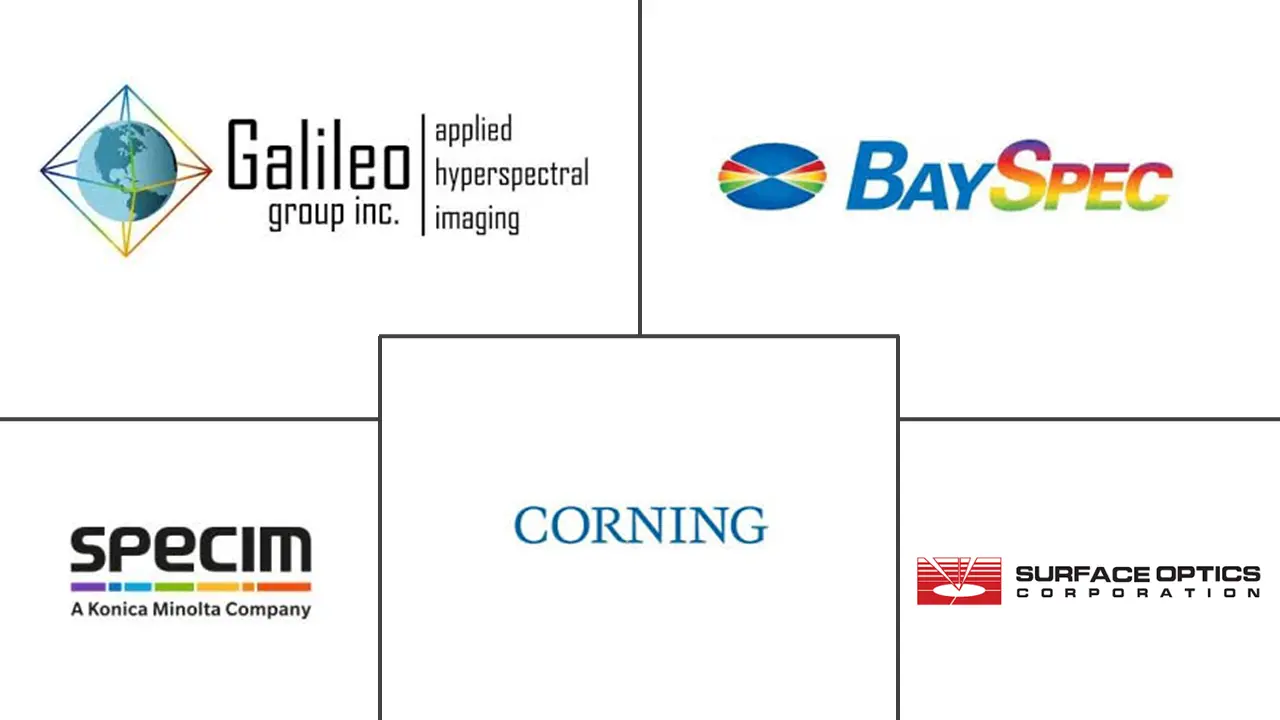Hyperspectral Imaging Market Size and Share
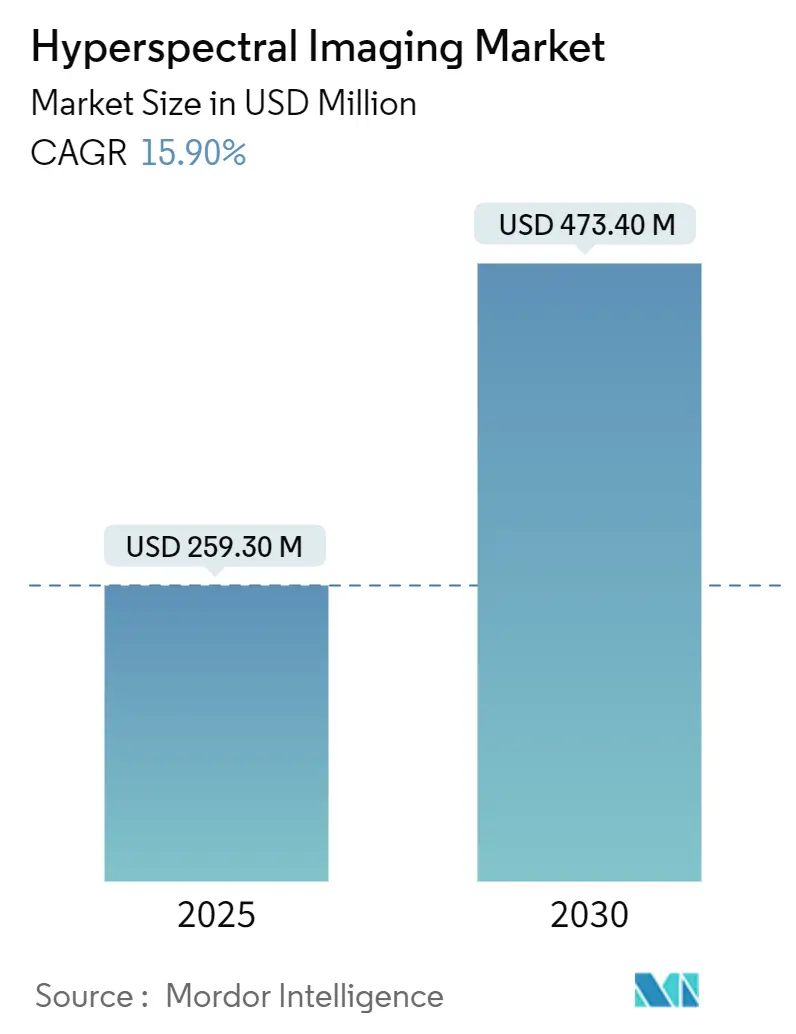
Hyperspectral Imaging Market Analysis by Mordor Intelligence
The hyperspectral imaging market size is estimated at USD 259.30 million in 2025, and is expected to reach USD 473.40 million by 2030, at a CAGR of 15.90% during the forecast period (2025-2030), underscoring rapid scale-up from research laboratories to factory floors. This expansion rests on falling VNIR/SWIR sensor prices, Defense Department contracts for space-borne constellations, and policy-backed precision-agriculture roll-outs across Asia Pacific. Vendors now embed machine-learning accelerators inside detectors, enabling in-field analytics that eliminate bulky workstations and shorten decision cycles to milliseconds. At the same time, miniaturized snapshot cameras shrink size, weight, and power by two orders of magnitude, opening consumer channels such as smartphone diagnostics. Program funding that exceeds USD 1.3 billion for U.S. government HSI missions guarantees recurring demand and accelerates spillover of defense-grade technology into civilian applications. [1]U.S. Government Publishing Office, “Senate Report 118-204 – Department of Defense Appropriations Bill, 2025,” govinfo.gov
Key Report Takeaways
- By offering, cameras captured 51% of hyperspectral imaging market size in 2024; service providers are growing at 16.3% CAGR to 2030.
- By technology, pushbroom systems held 62% of hyperspectral imaging market share in 2024, whereas snapshot systems recorded the fastest 16.9% CAGR to 2030.
- By wavelength, VNIR commanded 44% of hyperspectral imaging market size in 2024; SWIR is advancing at a 17% CAGR through 2030.
- By end-user industry, defense held 35% of the hyperspectral imaging market share in 2024. Food and agriculture is advancing at a 16% CAGR to 2030, the fastest among all segments.
- By geography, North America commanded 38% revenue while Asia Pacific is expanding at a 17% CAGR through 2030.
Global Hyperspectral Imaging Market Trends and Insights
Drivers Impact Analysis
| Driver | (~) % Impact on CAGR Forecast | Geographic Relevance | Impact Timeline |
|---|---|---|---|
| Integration of AI-based on-chip analytics | +3.2% | Global, with early adoption in North America and EU | Medium term (2-4 years) |
| Rapid cost erosion of VNIR/SWIR sensors | +2.8% | Global, led by APAC manufacturing hubs | Short term (≤ 2 years) |
| Expanding precision-agriculture programs in APAC | +2.1% | APAC core, spill-over to Latin America | Medium term (2-4 years) |
| DoD/DARPA funding for space-borne HSI constellations | +1.9% | North America, with allied nation participation | Long term (≥ 4 years) |
| Miniaturised "snapshot" HSI for smartphone diagnostics | +1.7% | Global, consumer-driven adoption | Medium term (2-4 years) |
| Mandatory ESG disclosure driving mineral-grade verification | +1.4% | Global, regulatory compliance-driven | Long term (≥ 4 years) |
| Source: Mordor Intelligence | |||
Integration of AI-based on-chip analytics
Edge neural networks now reside directly on detector arrays, pushing real-time throughput beyond 1.2 Tb/s. [2]Andrea Fratalocchi, “Hardware-Accelerated Integrated Optoelectronic Platform Towards Real-Time High-Resolution Hyperspectral Video Understanding,” Nature Communications, nature.com The U.S. Army’s HyperThreAD program demonstrates chemical threat recognition in seconds from UAV-borne cameras. [3]Brian Feeney, “Army Researchers Work to Enable Chemical Threat Scanning on the Fly,” DVIDS, dvidshub.net These advances cut latency, reduce bandwidth loads, and enable autonomous quality decisions in agricultural sorters, recycling robots, and industrial process lines. Broader commercial use is accelerating as thin-film filter stacks from Imec allow CMOS-level manufacturing, dropping unit costs while raising frame rates. As a result, AI-enabled detectors are poised to form the core of next-generation autonomous platforms in logistics, mining, and food safety.
Rapid cost erosion of VNIR/SWIR sensors
InGaAs wafer yields have doubled since 2024, and shared back-end packaging lines now mimic smartphone camera economics, pushing average selling prices down nearly 40% per year. [4]Ankit Singh, “Miniaturized Spectroscopy: The Future of Non-Invasive Chemical and Environmental Sensing,” AZoSensors, azosensors.com Cost parity with mid-range CMOS imagers is expected by 2027, moving hyperspectral cameras from capital expense to consumable tool in many production lines. UC Davis compressive-sensing prototypes cut optics mass by 100× without spectral fidelity loss, reinforcing this deflationary trend. [5]University of California Davis TTO, “Hyperspectral Compressive Imaging,” techtransfer.ucdavis.edu As prices retreat, the hyperspectral imaging market gains traction in automotive paint inspection, electronics failure analysis, and industrial metrology.
Expanding precision-agriculture programs in APAC
China, India, and ASEAN states collectively spend more than USD 15 billion a year on digital farming subsidies, making spectral data central to their food-security strategies. Drone platforms with multi-band payloads now scan up to 1,000 hectares daily, guiding fertilizer and irrigation in real time. Academic trials report disease-spotting accuracy beyond 90%, giving farming co-operatives a strong return on investment. Local manufacturing clusters for optical modules in Shenzhen and Bengaluru shorten supply chains and reduce import tariffs, further boosting uptake. By 2030, agriculture is expected to account for one in every five hyperspectral systems shipped.
DoD/DARPA funding for space-borne hyperspectral constellations
The FY 2025 U.S. defense budget earmarks more than USD 852 billion, with a dedicated line for spectral intelligence satellites. Commercial imagery contracts let startups like BlackSky and Planet lock in multiyear revenue while maturing hardware for civilian markets. Orbital Sidekick already flies seven satellites with 468 bands dedicated to methane and pipeline monitoring. Budget visibility through 2030 de-risks capital intensive detector fabs, encouraging suppliers to scale production capacity that also serves mining, maritime, and climate-monitoring users.
Restraints Impact Analysis
| Restraint | (~) % Impact on CAGR Forecast | Geographic Relevance | Impact Timeline |
|---|---|---|---|
| Persistent calibration drift in field-deployable units | -2.1% | Global | Short term (≤ 2 years) |
| High CAPEX and data-storage costs | -1.8% | Global | Medium term (2-4 years) |
| US-China export-control regimes on sensor cores | -1.4% | APAC supply chains | Long term (≥ 4 years) |
| Scarcity of domain-specific spectral libraries | -1.1% | Varies by sector | Medium term (2-4 years) |
| Source: Mordor Intelligence | |||
Persistent calibration drift
Temperature swings, vibration, and airborne contaminants degrade spectral alignment by more than 2% per month in unconditioned factories. While LED-based self-calibrators keep high-end airborne payloads within 5% uncertainty, their USD 50,000 price tag restricts use to premium systems. Budget units in food sorting and recycling plants still require weekly validation, disrupting workflows and lowering confidence among operators. Vendors that integrate sealed optics, on-board references, and adaptive algorithms are positioned to capture share as users seek maintenance-free uptime.
High CAPEX and data-storage costs
A megapixel camera streaming 1,000 spectral channels at 100 fps produces more than 1 TB of data per hour, necessitating high-throughput links and petabyte-scale archives. Industrial buyers spend upward of USD 500,000 for full turnkey rigs, with yearly cloud fees crossing USD 100,000 for always-on analytics. Edge compression chips and event-based sampling promise relief, yet budget-constrained SMEs often postpone adoption. Subscription-style “sensing-as-a-service” models could ease entry barriers but hinge on secure pipelines for proprietary information.
Segment Analysis
By Offering: Service Providers Narrow the Expertise Gap
The cameras segment captured 51% of the hyperspectral imaging market share in 2024, while service providers grew the fastest at a 16.3% CAGR. Turnkey models bundle sensor rental, flight operations, and spectral analytics, sparing end-users from steep learning curves. Headwall Photonics’ alliance with GRYFN exemplifies this managed-service pivot, pairing UAV payloads with cloud-native dashboards. Regulatory audits in defense and mining increasingly stipulate certified providers, reinforcing the segment’s momentum. System integrators sustain demand by customizing optics and illumination for machine-vision retrofits. QinetiQ US, for instance, curates spectral libraries for surveillance and environmental missions, monetizing software updates and data services over multiyear contracts

Note: Segment shares of all individual segments available upon report purchase
By Technology: Snapshot Speed Challenges Pushbroom Accuracy
Pushbroom scanners captured 62% of hyperspectral imaging market share in 2024 thanks to high SNR across long dwell times. Mining surveys and satellite payloads rely on the line-scan method’s uniform illumination and spectral fidelity. Snapshot imagers, however, posted a 16.9% CAGR, capturing full data cubes in a single frame and enabling handheld, jitter-free operation for field agronomy and medical endoscopy.
Hybrid innovations such as Specim’s FX-series thermal pushbroom camera marry mid-wave coverage with mechanical scanning to serve industrial furnaces and flare monitoring. Tunable-filter rigs address chemical sensing where selective bands suffice, while whiskbroom architectures retain relevance on high-altitude platforms demanding pinpoint targeting.
By Wavelength: SWIR Penetrates New Workflows
VNIR held 44% of hyperspectral imaging market size in 2024, underpinned by silicon-detector economies and vegetation indices. SWIR volumes are expanding at a 17% CAGR as indium-gallium-arsenide arrays fall in price, allowing moisture mapping, polymer sorting, and clandestine surveillance through haze. Uncooled LWIR concepts from Navy SBIR programs promise gas-cloud detection without cryocoolers, widening adoption in refinery safety. Multiband cameras covering 400–2,500 nm consolidate VNIR and SWIR in one product, simplifying logistics for drone operators. Cost cross-overs anticipated by 2027 could make SWIR an equal-cost alternative to VNIR for many use cases.
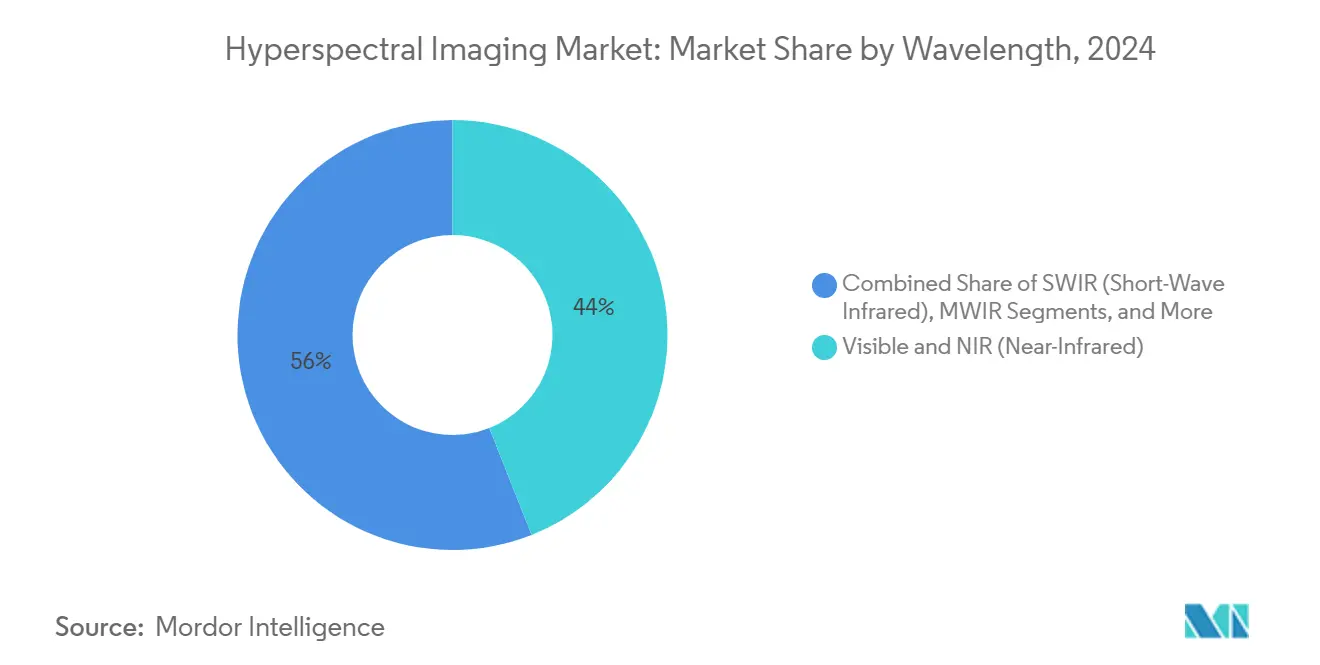
Note: Segment shares of all individual segments available upon report purchase
By End-User Industry: Defense Dominance Drives Innovation
Defense accounted for 35% of the hyperspectral imaging market share in 2024, supported by annual procurement budgets surpassing USD 850 billion in the United States alone. Continued investment in threat-detection payloads, camouflage-penetrating surveillance, and offshore monitoring ensures a reliable baseline of demand and accelerates breakthroughs in detector sensitivity and on-board processing. Food and agriculture, although smaller, is projected to expand at a 16% CAGR to 2030, benefitting from subsidies that prioritize yield optimization and chemical-free crop management.
Early adoption in defense has paid for the R&D that now trickles into precision farming, recycling, and healthcare diagnostics. Pilot programs in European meat-processing plants show 98% pathogen-detection accuracy, while mining firms deploy ruggedized units for rapid ore-grade screening. As manufacturing scale grows and software models mature, non-government buyers gain access to capabilities once reserved for intelligence agencies. This virtuous cycle raises overall hyperspectral imaging market size and builds a diversified demand portfolio that cushions against budget fluctuations.
Geography Analysis
North America led with 38% hyperspectral imaging market size in 2024, driven by strong defense allocations, NIH-funded medical imaging grants, and robust venture capital for dual-use space companies. Federal five-year imagery contracts guarantee steady revenue streams, while Silicon Valley startups tap USD 24 million-plus Series A rounds to build low-Earth-orbit constellations. Cross-border collaboration with Canada on Arctic monitoring generates incremental sensor orders and data-processing services.
Asia Pacific posts the fastest expansion at 17% CAGR, propelled by China’s Digital Village Initiative and India’s agri-tech subsidies, both mandating real-time crop-health reporting. Regional semiconductor clusters around Suzhou, Hsinchu, and Osaka shorten lead times and compress costs, letting local drone integrators bundle spectral payloads below USD 10,000. Governments also field-test HSI for river-pollution tracking and rare-earth exploration, adding multi-year pipeline visibility.
Europe maintains balanced growth anchored in circular-economy regulations. The EU target of 65% municipal-waste recycling by 2030 creates a stable pull for optical sorters, while ESA-backed Copernicus expansion funds hyperspectral satellite services. Germany champions industrial automation, France focuses on vineyard disease prediction, and Nordic countries leverage HSI for timber-quality grading. Regional data-sovereignty rules stimulate local cloud providers to offer compliant analytics stacks, reinforcing domestic value retention.
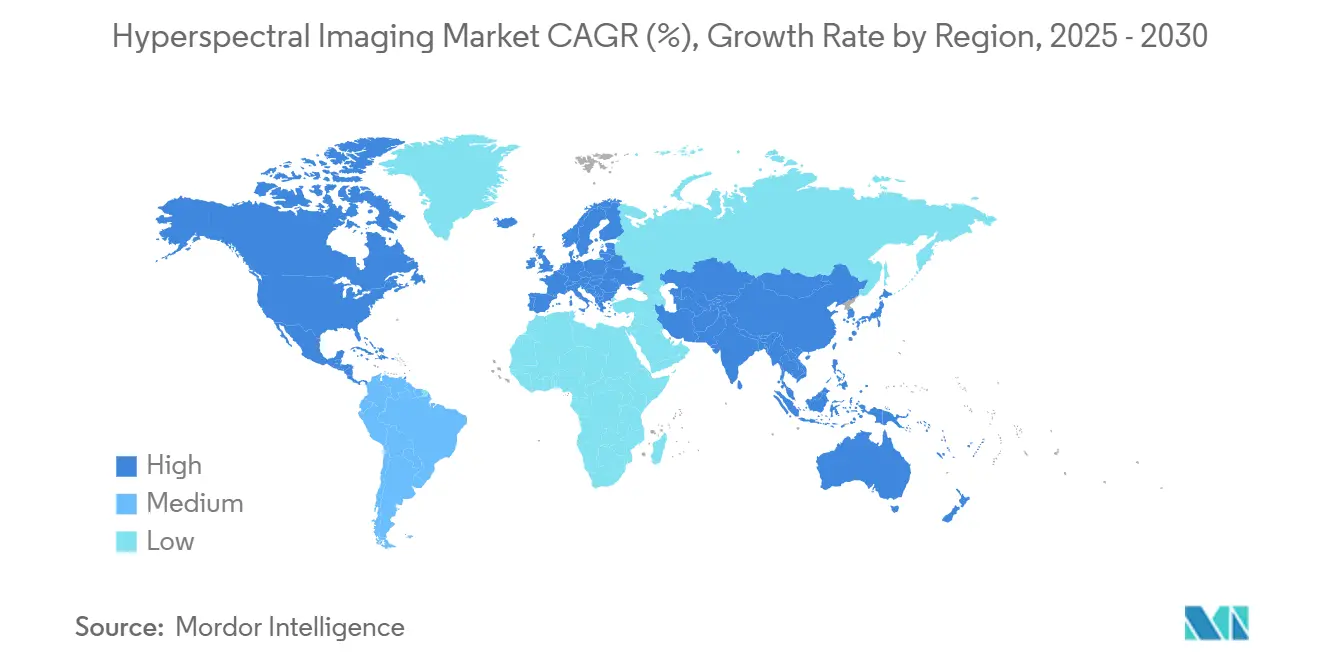
Competitive Landscape
The hyperspectral imaging market demonstrates moderate consolidation. Headwall Photonics’ 2024 and 2025 purchases of inno-spec and EVK added turnkey machine-vision software to its airborne and line-scan portfolio, providing cross-sell synergies in European recycling and food factories. Konica Minolta’s 2025 buyout of Finland-based Specim signals mainstream imaging brands pushing into spectral territory, leveraging far-larger sales networks to evangelize the technology.
At the same time, venture-backed entrants such as Pixxel and HyperSpectral pivot on asset-light constellations or hardware-agnostic AI platforms, raising USD 67.3 million across ten disclosed rounds. Their agility lies in subscription analytics rather than box sales, challenging incumbents whose value proposition historically centered on bespoke instrumentation. Incumbents respond by bundling cloud dashboards and pay-per-scan models.
White-space opportunities persist in consumer electronics, in-line semiconductor inspection, and energy infrastructure monitoring. Suppliers that control both detector fabrication and proprietary AI pipelines are best positioned to defend margins as hardware commoditizes. Those reliant on reselling third-party sensors may face pricing pressure once Chinese fabs reach volume parity.
Hyperspectral Imaging Industry Leaders
-
Galileo Group, Inc.
-
BaySpec Inc.
-
Specim Spectral Imaging Ltd
-
Corning Incorporated
-
Surface Optics Corporation
- *Disclaimer: Major Players sorted in no particular order
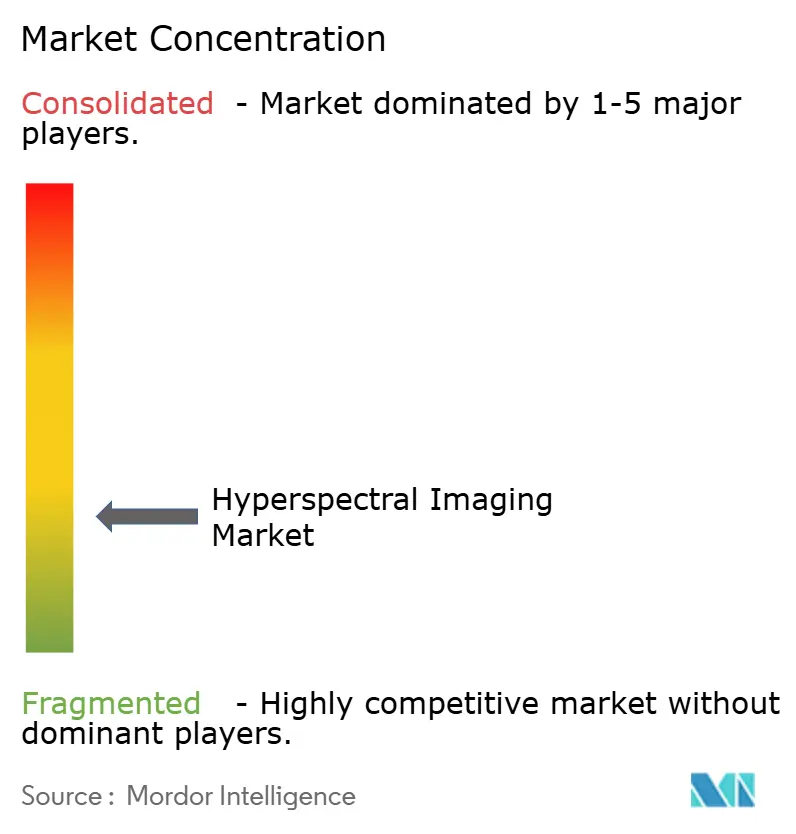


Recent Industry Developments
- February 2025: Konica Minolta’s Sensing Business Unit completed the acquisition of Specim, aiming to embed spectral analytics into safety, security, and environmental portfolios.
- January 2025: Headwall Group bought EVK DI Kerschhaggl GmbH, strengthening its European presence and adding chemometric classifiers for industrial sorters.
- June 2024: HyperSpectral closed an USD 8.5 million Series A to scale its SpecAI software, reflecting investor appetite for hardware-agnostic spectral intelligence.
- August 2024: Imec released a 450–900 nm space-grade sensor, targeting small satellites that need high uniformity at low mass.
Global Hyperspectral Imaging Market Report Scope
The scope of the study primarily includes different types of cameras/imagers that are used for hyperspectral imaging applications, and the market is defined by the revenues accrued from the sale of these cameras across end-user industries, including food and agriculture, healthcare, defense, mining and metrology, recycling, among others.
The hyperspectral imaging market is segmented by end-user industry (food and agriculture, healthcare, defense, mining and metrology, recycling, and other end-user verticals) and by geography (North America, Europe, Asia Pacific, and Rest of the World). The market sizes and forecasts are provided in terms of value USD for all the above segments.
| Cameras |
| System Integrator |
| Service Provider |
| Pushbroom |
| Snapshot |
| Tunable Filter |
| Imaging FTIR |
| Whiskbroom |
| Visible and NIR (Near-Infrared) |
| SWIR (Short-Wave Infrared) |
| MWIR (Mid-Wave Infrared) |
| LWIR (Long-Wave Infrared) |
| Food and Agriculture |
| Healthcare |
| Defense |
| Mining and Metrology |
| Recycling |
| Other End-user Industries |
| North America | United States | |
| Canada | ||
| Mexico | ||
| South America | Brazil | |
| Argentina | ||
| Rest of South America | ||
| Europe | Germany | |
| United Kingdom | ||
| France | ||
| Italy | ||
| Spain | ||
| Rest of Europe | ||
| Asia Pacific | China | |
| Japan | ||
| India | ||
| South Korea | ||
| ASEAN | ||
| Rest of Asia Pacific | ||
| Middle East and Africa | Middle East | Saudi Arabia |
| United Arab Emirates | ||
| Rest of Middle East | ||
| Africa | South Africa | |
| Egypt | ||
| Rest of Africa | ||
| By Offering | Cameras | ||
| System Integrator | |||
| Service Provider | |||
| By Technology | Pushbroom | ||
| Snapshot | |||
| Tunable Filter | |||
| Imaging FTIR | |||
| Whiskbroom | |||
| By Wavelength | Visible and NIR (Near-Infrared) | ||
| SWIR (Short-Wave Infrared) | |||
| MWIR (Mid-Wave Infrared) | |||
| LWIR (Long-Wave Infrared) | |||
| By End-user Industry | Food and Agriculture | ||
| Healthcare | |||
| Defense | |||
| Mining and Metrology | |||
| Recycling | |||
| Other End-user Industries | |||
| By Geography | North America | United States | |
| Canada | |||
| Mexico | |||
| South America | Brazil | ||
| Argentina | |||
| Rest of South America | |||
| Europe | Germany | ||
| United Kingdom | |||
| France | |||
| Italy | |||
| Spain | |||
| Rest of Europe | |||
| Asia Pacific | China | ||
| Japan | |||
| India | |||
| South Korea | |||
| ASEAN | |||
| Rest of Asia Pacific | |||
| Middle East and Africa | Middle East | Saudi Arabia | |
| United Arab Emirates | |||
| Rest of Middle East | |||
| Africa | South Africa | ||
| Egypt | |||
| Rest of Africa | |||


Key Questions Answered in the Report
How fast is the hyperspectral imaging market expected to grow through 2030?
It is forecast to expand at a 15.9% CAGR, rising from USD 259.3 million in 2025 to USD 473.4 million by 2030.
Which application segment currently generates the largest revenue?
Defense applications hold 35% hyperspectral imaging market share, anchored by national security funding and advanced surveillance needs.
Why is Asia Pacific the fastest-growing region?
Government-funded precision-agriculture programs, expanding semiconductor capacity, and supportive subsidies push regional CAGR to 17% through 2030.
What technology trend is most disruptive in this space?
AI-based on-chip analytics now processes terabit-scale data in real time, reducing latency and enabling autonomous decision-making at the edge.
How are vendors tackling high data-storage costs?
Suppliers integrate edge compression, offer subscription analytics, and design event-driven sensors that lower data volumes without sacrificing spectral fidelity.
Who are the key players shaping competitive dynamics?
Headwall Photonics, Specim-Konica Minolta, and Princeton Infrared Technologies rank among the leaders, collectively holding roughly 41% of 2024 revenue.
Page last updated on:
